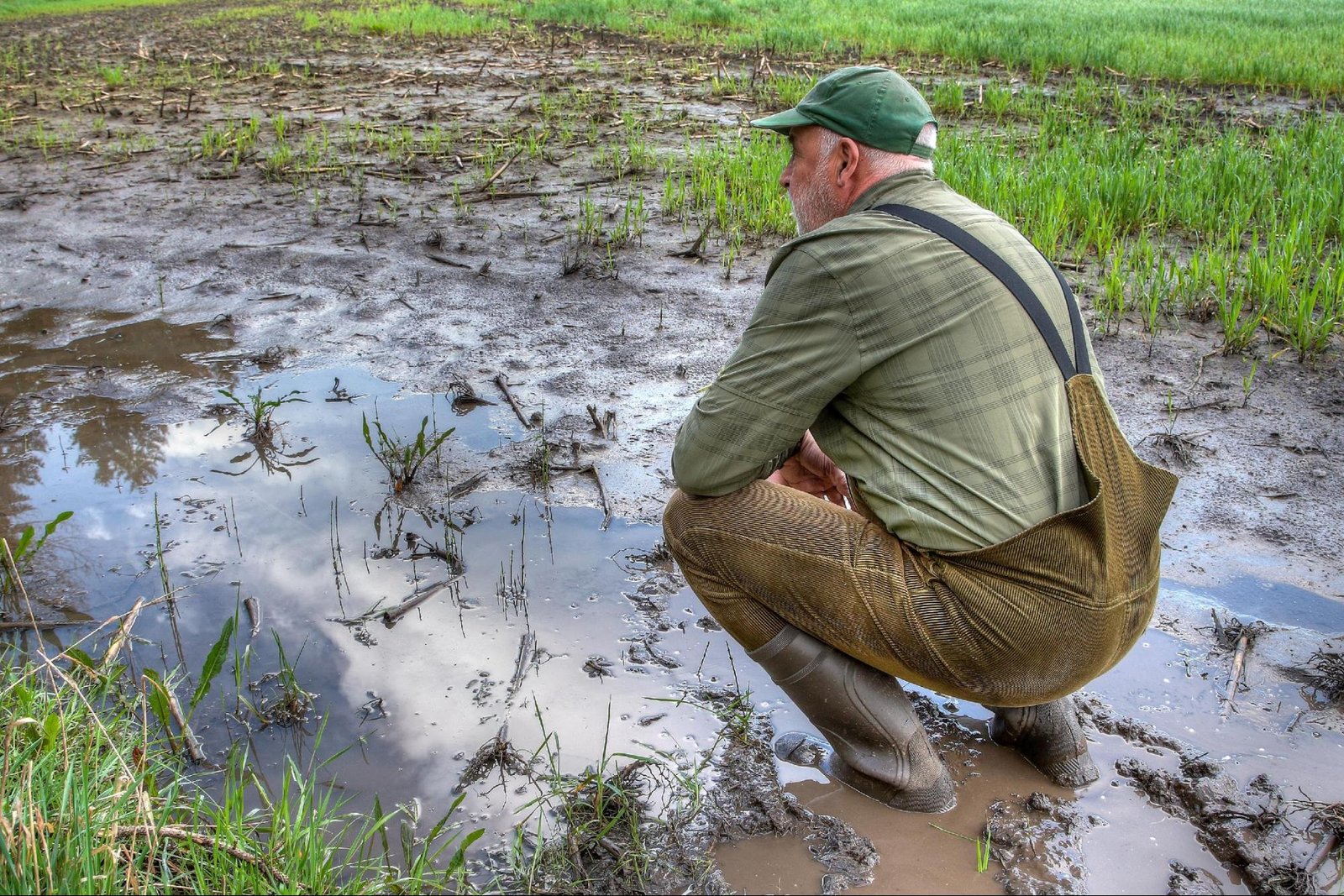
Image: surveyor checking stones on the ground.
Planners have been discussing the confluence of housing and environmental issues in respect of Biodiversity Net Gain (BNG). Here are the main points:
Key questions?
- What legal requirements stem from the 2021 Environment Act?
- What is needed for successful implementation?
- Following the mitigation hierarchy, how do we balance gains on and off-site whilst ensuring the project remains viable?
- How can planners work with private companies, developers, landowners, and adjacent local authorities to deliver BNG beyond the site?
1. Biodiversity Net Gain (BNG) came into law through the Environment Act and will be factored into planning applications
The Environment Act 2021 established BNG, which allows you to obtain funding for the natural environment. Planning permission for new developments – whether through the Town & Country Planning Act or national infrastructure projects – must now demonstrate how a minimum of 10% BNG can be achieved, either through a combination of onsite and offsite measures or entirely through offsetting.
2. Developers must measure BNG and report findings via a National Register
Initially, the developer, aided by his or her environmental consultants, will apply the DEFRA Metric 3.0 to the specific development site. This will be used to work out the number of biodiversity units. So, for instance, if the site is found to be hosting around 100 such units, the developer then has to provide an increase of a minimum of 10% (10 units more) on top of that.
The planning authority, however, could decide that more needs to be done and insist that 20% or even 25% more units be provided (that means 20 or 25 units more on top of the original 100). The uplift amount—what needs to be provided—is known as the BNG requirement.
When authorities assess a site, they might determine that there is a certain amount of biodiversity (e.g. 100 units). This requires a 10% increase over the original value. For some authorities, they may require 15%, 20%, or even 25%.
The mitigation hierarchy then gets applied by the developer. Some portion of the overall BNG requirement is kept and implemented onsite, but we believe a significant portion of it will need to be placed offsite into either a bespoke offset project that uses the developer’s land or by purchasing BNG Credits that are offset by habitat banks like those in our network.
The net gain plan for Biodiversity Net Gain from the developer must be completely clear, and the developer must guarantee that a net gain in biodiversity will occur, be delivered, and be maintained on-site for at least 30 years. If the developer can’t find any local landowner to purchase BNG units from, then they can buy statutory credits from Natural England as a last resort.
All onsite or offsite BNG units must be registered on the DEFRA register.
3. Local Planning Authorities can not try to sell Biodiversity Units themselves
LPAs could advance their own sites for BNG units. However, this endeavour would need to be executed via a commercial vehicle—just as other income-generating ventures by local councils are.
When trying to get BNG delivered on their land, local authorities must be careful of state aid rules and be anti-competitive. They must make sure their land is properly registered and then underwrite and guarantee funding for it for 30 years before they can sell the developer any credits.
Funding from the developers they regulate poses a risk of conflict of interest for LPAs. Strategic operation is a must for LPA sites and they need to evaluate the developer’s plans for BNG, or they can bypass all that and use a Habitat Bank provider via us.

Image: surveyor in swampy field.
4. BNG compliance will be enforced by Planners
Regarding delivery, developers must apply the DEFRA metric transparently and ensure that the BNG gain plan is unambiguous. This is vital to enabling the hope that legal challenges to developers will be avoided in the future.
The onsite model requires not just a delivery of services for 30 years but also an assured management of the site well enough that any stored carbon remains there for its intended duration. Developers need to have a clear and firm means not just of delivering what is needed or promised but also of managing those delivered promises to ensure that what needs to stay on site does stay on site for a long time.
LPAs will have greater enforcement powers to ensure that developers comply with their obligations. There is ample reason to think that, like all forms of compliance, onsite compliance will require a system of accreditation and certification to work well. There are many reasons to prefer onsite to offsite provision, but if developers want to avoid the added hassle and headache of a tightly constrained onsite system, they should consider offsite provision. This means purchasing offsite “credits” from, for example, a Habitat Bank, in order to satisfy the need for “provision” of offsetting habitat.
5. Local Planning Authorities can submit land for Habitat Banks
When it comes to landowners, farmers, conservation groups, local planning authorities, and developers, all can promote BNG sites. They can put forward their own scheme directly, or they can engage with organizations like ours to work with Habitat Banks, funding their own projects for a guaranteed 30 years and taking on no risk.
Substantial funding has been secured to partner with local planning authorities (LPAs), allowing land agents to provide over 3,000 hectares in the next 3 years. Working alongside these LPAs and our other partners, we aim to assist Habitat Banks and we expect to at least have one Habitat Bank per LPA area.
6. Habitat Banks improve the Biodiversity Value of Land
The most significant enhancement of biodiversity occurs when intensively farmed arable land, typically grade 3 or 4 arable land, is transformed into areas akin to species-rich wildflower meadows, diverse grasslands, woodlands, wetlands, or rewilded spaces. The management of these areas, under the auspices of the Habitat Banks, and the management of areas where we have uplifted biodiversity gives us the credits to sell to buyers.
7. Habitat Banks enable Local Planning Authorities to discharge their duty in respect of BNG reporting
The top priority must be that the units/credits for biodiversity net gain must be secured before the development starts. This is a guarantee to the local planning authority that the BNG will be in place and working. For example, the LPA won’t agree to a phased approach where a developer only sorts out the credits once they’re already underway with their development.
Despite this being a relatively straightforward business model, the costs to the developer for securing the units or credits isn’t huge compared to the alternative of using valuable land for developable space.
All correspondence with the LPA is assisted by us, and we establish all necessary monitoring and reporting so that the LPA can fulfil its duty regarding BNG reporting.

Image: surveyor checking plants.
8. Habitat Banks limit the risk of BNG for Local Planning Authorities
The model of the Habitat Bank serves to greatly reduce the risk involved for local planning authorities (LPAs). They do not need to procure the capacity to deliver and monitor biodiversity net gain. LPAs face zero risk of judicial review since Habitat Banks take on the liability for delivery, and there is no need for LPAs to underwrite projects for 30 years. Political objections that could threaten the independence of LPAs are not a concern with this model since the entities that transact deals are politically neutral. Finally, there is no need to establish a commercial entity since the Habitat Bank operates on a for-profit basis.
There is no need for developers to find the capability to carry out and oversee BNG because Habitat Banks take on all the responsibility for delivery, leaving developers with no risk of judicial review to worry about. There’s also no need for them to underwrite sites for 30 years of funding.
Conclusion
We believe that Habitat Banks realize the promise of “biodiversity offsetting” at a scale that makes them viable. However, we do not believe offsets to be viable when they are delivered in small, fragmented areas. Even if such areas were durably managed—a condition we think unlikely for the next 30 years—these small pockets do not satisfy key conservation principles (the Lawton principles) that call for biodiversity to be “bigger, better and joined.” Instead, we aim to help you create large, fully-funded protected areas that have “maximum biodiversity” with guaranteed future.
Guidance for Planners
Habitat Banks provide a robust and straightforward mechanism for LPAs to comply with the Environment Act 2021 and the National Planning Policy Framework (NPPF). There is no cost to the local planning authority or the taxpayer; it removes liability from the authority if it were contemplating future Habitat Banks of its own. This is a win-win solution for your local authority, and it is at no risk to the LPA.
For more information, please get in touch with our team.
Guidance for Developers
For developers, it allows them to see what’s coming in the planning system, and they are not on the hook for taking care of the development site for 30 years, nor are they funding its long-term management. You can’t do BNG commercially on-site so easily, as there just isn’t the space.
It’s also not a huge cost. BNG units cost in the vicinity of less than 0.5% of gross development value, and we end up with larger and better-scaled sites that bring real biodiversity restoration to our communities and contribute towards the ambitious nature recovery network the government has set out.
For more information, please get in touch with our team and, for BNG Credit enquiries, please complete our “Biodiversity Unit Request” contact form.
Guidance for Landowners
The Habit Bank will provide guaranteed payments to the landowner and we assist you through the process. The sites provide secure income diversification.
For more information, please get in touch with our team and, if you are a landowner interested in Habitat Bank creation, please complete our “Register Your Land” form to get started.


